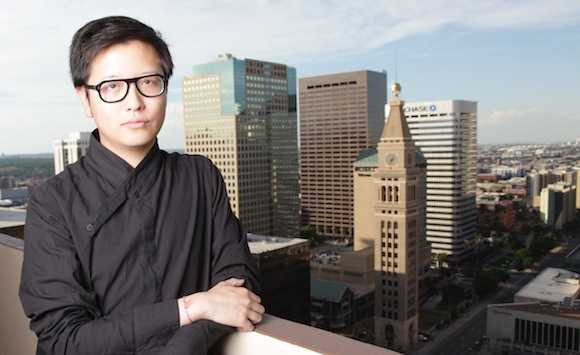Draft Urbanism, the core exhibition program in the latest edition of the Denver-based Biennial of the Americas, brings together practitioners in art, architecture, and film from across the Americas to examine our evolving relationship with the physical and social fabric of our cities. The biennial features a series of newly commissioned works in various public spaces throughout Denver, from breweries to highway medians. Carson Chan, architecture writer and curator, and co-founder of architecture collective Program (Berlin), is Executive Curator of this year’s edition.
Carson Chan in Denver. Photograph: Anthony Camera.
KAREN ARCHEY: Draft Urbanism seems to be more inclusive and unique than your average biennial. Could you describe the curatorial purview and physical format of the biennial, and explain how it is a departure from the standard biennial (i.e. Lyon, Venice)? How does it relate to the biennial you organized in Marrakech last year?
CARSON CHAN: One thing that's great about making a biennial exhibition in Denver is that there is not much precedence here for this format. For many in Denver, the word "biennial" doesn't immediate recall a preset image of a large-scale exhibition like you might find in cities with long traditions of making these things. There is a tremendous amount of freedom in that we can define our goals without having to go by received assumptions of how things are done. Basically, there's no real need to follow pre-existing, European models. It's a pioneering attitude that goes down rather well in Denver. The Biennial of the Americas is separated into two main parts: lectures and workshops, and art. The art portion of the biennial is called Draft Urbanism and it's a show about seeing urbanism as a never-ending process, suggesting that the current version of the city we live in is but a draft of something else.
Marrakech taught me a lot, namely that there is no need to make an exhibition in a gallery or museum. The art projects we installed in public spaces there were seen by far more people than the exhibitions we had indoors—even though it was free. It's really hard to get people that don't have an existing interest in contemporary art to go to a museum, so why not bring the art out in the public? I think that professional often make exhibitions in museums and galleries because it's easy, not because it best serves the public. Draft Urbanism is exhibited entirely in public space in downtown Denver. All the artwork will be exhibited on billboards, posters, bus shelters and public LED screens, and four large-scale architecture installations were commissioned to directly address urban issues in Denver.
KA: What are some of these urban issues?
CC: We're addressing the excess of surface parking lots throughout the downtown area, the impediment that multi-lane streets pose to urban development, the better uses to which unactivated public spaces could be put, and perhaps the toughest one, the perception of what is desirable and not in the public. Many homeless in Denver use of the city's main outdoor shopping destination, the 16th Street Mall. Artist and architect Alex Schweder, Chilean architects Pezo von Ellrichshausen, plan:b architects from Medellín, Colombia, and June14 architects will be articulating these questions through their installations. Expect a moving hotel, a 50-foot tall wooden structure, "cloud-like" public furniture, and butterfly enclosures suspended from the tops of buildings. We're really happy to have Michael Webb here for a panel discussion as well. He's one of the founding members of the British conceptual architecture group, Archigram. They were thinking through very much the same issues that plague our cities now.
KA: This lack of precedence for the biennial format in Denver reminds me of the origins of documenta in Kassel, Germany. Kassel is a similarly small city, and the quintennial's founder, Arnold Bode, structured the exhibition around his own idiosyncratic curatorial vision rather than the typical approach to the biennial in that (pre-internet) era. I would argue that this involved culling and contextualizing the great art of the time, focusing on specific geographic locations because world travel and information gathering were both drastically more resource-consuming in the mid-20th century. You seem to be taking a less authorial approach as compared to someone like Bode, or his contemporary analogs, such as Massimiliano Gioni, who is seemingly continuing the tradition of authorial biennial curating after the dawn of widespread internet usage. You seem to have a political and ethical commitment to both the city and biennial format. Could you describe your relationship to the role of the biennial curator in the context of post-internet discourse?
CC: Great question. There's been a lot of talk about post-internet art, but not much regarding post-internet curating. In your own texts, you've mentioned the "specter of the internet" - its traces - as a key identifier of the post-internet condition, but I would simply state that post-internet is an internet state of mind. I guess we can characterize it as being dispersed, referential and bringing new attention to materiality through its very negation of it. The internet has amped up the rate at which we communicate through speech, text, images and video. Think about art announcement services like e-flux, social networks that show us images and videos from around the world like Facebook, Instagram and Twitter. Guy Debord famously wrote that, "everything that was directly lived has moved away into representation." This has never been more true, and it’s why I’ve invited one of the foremost observers of this condition, Douglas Coupland, as a participant. In the arts, when we say we've seen a show or know it, what we often mean is that we've seen online images of it. Draft Urbanism takes this condition, and tries to force through an exhibition experience that cannot possibly be photographed or represented—you had to be there. With more than 30 billboards, bus shelters, LED screens and posters around town, there will not be any one image that could capture the exhibition. In a sense, the city becomes one giant exhibition. In fact, we're putting museum labels throughout downtown locations where there’s a direct view of the work, and we're also working with a Denver historian to put museum labels on buildings and locations in downtown that deal directly with our theme—which is, in short, urbanism and beer.

KA: This inability to totally experience the biennial through representation reminds me a lot of Skulptur Projekte Münster, a decennial (occurring once per decade), which often feels like an Easter egg hunt when searching for various art projects. Speaking of urbanism and beer, I love that you're using the homograph "draft" to both speak to this contemporary condition you just so expertly explained in addition to referencing Denver's long tradition of beer brewing. How do these ideas connect for you beyond semantic similarity?
CC: Well, it's about understanding urbanism as a process that is simultaneously future oriented, while being historically grounded—a very basic idea, but one that is rarely heeded. Beer, let's say, is seen not only as only a beverage, but as part of a material system that organizes everything from physical infrastructure (factories and roads were constructed for production and distribution), to history (Denver's civic history is closely tied to the history of its bars and taverns), to local identity—Colorado boasts more craft breweries per capita than anywhere else in the world. This view refers to a materialist concept that Mexican philosopher Manuel de Landa has laid out in his book, A Thousand Years of Nonlinear History (1997), and continues to be influential in both art and architecture theory. In it, he weaves out a material relation between lava flows and human creativity—a great read!
KA: In an interview you conducted with Aaron Moulton, curator at the Utah Museum of Contemporary Art in Salt Lake City for the current issue of SpikeArt Quarterly, you speak about issues surrounding the regional context of curating in the American Mountain West. I would pose a similar question to you: In your curatorial efforts for the Biennial of Americas, how do you create an audience when there is little pre-existing audience in a non-coastal city such as Denver? As a curator, I'd imagine it's somewhat scary to launch a biennial in such a context, which must be magnified by the exhibition being inherently "undocumentable” and therefore inaccessible to audiences elsewhere?
CC: Well, I would nuance your question by adding that in fact there is not only an existing audience for art, there is also a large population that is very curious about contemporary art. There's more than a dozen institutions of higher learning in Denver, not to mention the art programs at the University of Colorado Denver and the Rocky Mountain College of Art and Design. Local gallerists like Adam Gildar or curators like William Morrow and Cortney Stell (who is the biennial's associate curator) are making shows that really challenge the audiences here. Draft Urbanism is not only targeting the groups that are already interested, but as I mentioned earlier, we're also interested in engaging people that are just walking or driving around downtown Denver. What is perhaps scarier would be to make a museum show with Draft Urbanism's theme; the common perception is that an exhibition about urban development could be pretty dry. Showing work in public—artwork on billboards across town and installations in parking lots, at major intersections and down the median—the viewer doesn't necessarily need to know they are looking at art in order to engage. The trick is to produce a double take—where viewers begin to question what it is they are looking at.
KA: Urban development and beer make for an exciting combination! And your participant list seems anything but dry, but rather expansive in terms of its participants’ ages, roles in art and/or architecture, and nationalities. We see very young artists such as Amalia Ulman and more established ones such as Liam Gillick and Michael Snow, as well as architectural groups such as the Colombia-based plan:b and June14. What was your intention in bringing together such a heterogeneous group of participants?
CC: The Biennial of the Americas, an initiative that was first envisioned by former Denver Mayor, and current Colorado Governor, John Hickenlooper, began with a pretty enterprising mandate to make Denver into a biennial hub for culture and current issues of North, Central and South America, so the diversity of the participants reflect this ambition. Also, metropolitan centers are by nature heterogeneous so an exhibition about the city, held throughout the city, would logically reflect this condition. Two participants that I would like to call out are Charlie Berger and Patrick Crawford from the Denver Beer Company, who have brewed a beer specifically based on Draft Urbanism's curatorial concept. It will be served throughout the seven weeks of the exhibition; touring the exhibition, seeing all the installations and billboards around town will be like a pub-crawl.
Carson Chan is an architecture writer and curator. Last year, along with Nadim Samman, he curated the 4th Marrakech Biennale. He is editor at large at 032c, and contributing editor at Kaleidoscope Magazine. In October of this year, Chan is co-organizing a conference at Yale School of Architecture with David Andrew Tasman and Prof. Eeva-Liisa Pelkonen about both historical and contemporary practices of architecture exhibition making.


